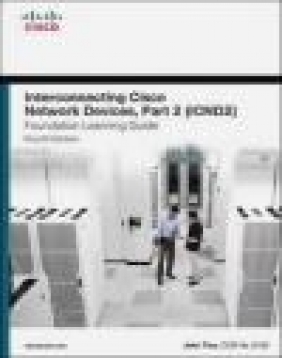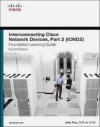Interconnecting Cisco Network Devices, Part 2 (ICND2) Foundation Learning Guide
John Tiso
Interconnecting Cisco Network Devices, Part 2 (ICND2) Foundation Learning Guide
John Tiso
- Producent: Cisco Press
- Rok produkcji: 2013
- ISBN: 9781587143779
- Ilość stron: 464
- Oprawa: Twarda
Niedostępna
Opis: Interconnecting Cisco Network Devices, Part 2 (ICND2) Foundation Learning Guide - John Tiso
This Cisco-authorized, self-paced foundation learning tool helps you prepare for both the 200-101 ICND2 and 200-120 CCNA exams. It delivers the higher level of foundational knowledge you need to prepare for the ICND2 exam (and the ICND2 components in the CCNA Composite exam), and to succeed in a wide range of Cisco networking job roles. This book teaches with numerous examples, illustrations, and real-world scenarios, helping you rapidly gain both expertise and confidence. Its coverage ranges from internetworking essentials to advanced diagnostic and debugging techniques that are needed by virtually all Cisco professionals. The book teaches you the technology and theory for building and troubleshooting medium to large scale internetworks, including an in-depth study of VLANs as well as redundancy technologies such as HSRP, STP, and EtherChannel. Additional topics include: implementing scalable mid-sized networks; troubleshooting basic connectivity; implementing EIGRP solutions and OSPF-based scalable multiarea networks; understanding WAN technologies; managing network devices; and advanced troubleshooting. This edition has been fully updated to reflect Cisco's latest exam blueprints. Content has been reorganized, simplified, and expanded to help you learn even more efficiently. The book presents you with information applicable to the CCNA that can't be found in any other CCNA text, including an overview and primer of MPLS, real-world examples, and real-world information on how to more effectively work with the Cisco TAC and diagnose software defects. The book also shows you how to use the Cisco 'Debug' command to learn how protocols work. Interconnecting Cisco Network Devices, Part 2 (ICND2) Foundation Learning Guide, Fourth Edition is part of a recommended learning path from Cisco that includes simulation and hands-on training from authorized Cisco Learning Partners and self-study products from Cisco Press. To find out more about instructor-led training, e-learning, and hands-on instruction from authorized Cisco Learning Partners worldwide, please visit www.cisco.com/go/authorizedtraining. * VLANs, Spanning Tree Protocol (STP), Hot Standby Routing Protocol (HSRP), and EtherChannel * Troubleshooting basic connectivity in IPv4, IPv6, and virtualized network environments * EIGRP theory, operation, and troubleshooting (IPv4 and IPv6) * OSPF terminology, operation, configuration, and troubleshooting (IPv4 and IPv6) * WAN technologies, terminology, theory, configuration, and troubleshooting * VPNs and WANs: comparisons and integration * Device management with SNMP, SYSLOG, and Cisco Flexible NetFlow * Cisco Integrated Service Routers: architecture, configuration management, Cisco IOS software images, and licensing * Advanced diagnostics, Cisco IOS software bugs, and debuggingIntroduction xviii Chapter 1 Implementing Scalable Medium-Sized Networks 1 Understanding and Troubleshooting VLANs and VLAN Trunking 2 VLAN Overview 2 Trunk Operation 6 Configuring Trunks 7 Dynamic Trunking Protocol 8 VLAN Troubleshooting 9 Trunk Troubleshooting 10 Building Redundant Switch Topologies 11 Understanding Redundant Topologies 12 BPDU Breakdown 15 STP Types Defined 20 Per-VLAN Spanning Tree Plus 21 Analyzing and Reviewing STP Topology and Operation 24 Examining Spanning-Tree Failures 26 STP Features: PortFast, BPDU Guard, Root Guard, UplinkFast, and BackboneFast 28 Improving Redundancy and Increasing Bandwidth with EtherChannel 29 EtherChannel Protocols 31 Port Aggregation Protocol 31 Link Aggregation Control Protocol 32 Configuring EtherChannel 33 Checking EtherChannel Operation 34 Understanding Default Gateway Redundancy 36 Hot Standby Router Protocol 37 HSRP Interface Tracking 38 HSRP Load Balancing 39 HSRP in Service Deployments 39 HSRP in IPv6 40 Gateway Load-Balancing Protocol 40 Chapter Summary 42 Review Questions 42 Chapter 2 Troubleshooting Basic Connectivity 47 Troubleshooting IPv4 Basic Connectivity 48 Components of End-to-End IPv4 Troubleshooting 48 Verification of Connectivity 51 Cisco Discovery Protocol 58 Verification of Physical Connectivity Issues 60 Identification of Current and Desired Path 63 Default Gateway Issues 66 Name Resolution Issues 68 ACL Issues 71 Understanding Networking in Virtualized Computing Environments 72 Troubleshooting IPv6 Network Connectivity 75 Understanding IPv6 Addressing 75 IPv6 Unicast Addresses 76 Components of Troubleshooting End-to-End IPv6 Connectivity 78 Verification of End-to-End IPv6 Connectivity 79 Neighbor Discovery in IPv6 80 Identification of Current and Desired IPv6 Path 82 Default Gateway Issues in IPv6 82 Name Resolution Issues in IPv6 83 ACL Issues in IPv6 84 IPv6 in a Virtual Environment 86 A Last Note on Troubleshooting 86 Chapter Summary 88 Review Questions 88 Chapter 3 Implementing an EIGRP Solution 91 Dynamic Routing Review 92 Routing 92 Routing Domains 92 Classification of Routing Protocols 93 Classful Routing Versus Classless Routing 94 Administrative Distance 95 EIGRP Features and Function 98 EIGRP Packet Types 100 EIGRP Path Selection 101 Understanding the EIGRP Metric 103 EIGRP Basic Configuration 105 Verification of EIGRP Configuration and Operation 106 EIGRP Passive Interfaces 108 Load Balancing with EIGRP 111 Variance 112 Traffic Sharing 113 EIGRP Authentication 114 Troubleshooting EIGRP 115 Components of Troubleshooting EIGRP 115 Troubleshooting EIGRP Neighbor Issues 118 Troubleshooting EIGRP Routing Table Issues 121 Issues Caused by Unadvertised Routes 121 Issues Caused by Route Filtering 122 Issues Caused by Automatic Network Summarization 123 Implementing EIGRP for IPv6 124 EIGRP IPv6 Theory of Operation 124 EIGRP IPv6 Feasible Successor 128 EIGRP IPv6 Load Balancing 129 EIGRP for IPv6 Command Syntax 130 Verification of EIGRP IPv6 Operation 131 EIGRP for IPv6 Configuration Example 133 Troubleshooting EIGRP for IPv6 135 Chapter Summary 136 Review Questions 137 Chapter 4 Implementing a Scalable Multiarea Network with OSPF 143 Understanding OSPF 143 Link-State Routing Protocol Overview 144 Link-State Routing Protocol Data Structures 145 Understanding Metrics in OSPF 146 Establishment of OSPF Neighbor Adjacencies 147 Building a Link-State Database 149 OSPF Area Structure 150 OSPF Area and Router Types 150 Link-State Advertisements 153 Multiarea OSPF IPv4 Implementation 154 Single-Area vs. Multiarea OSPF 155 Stub Areas, Not So Stubby Areas, and Totally Stub Areas 155 Planning for the Implementation of OSPF 158 Multiarea OSPF Configuration 158 Multiarea OSPF Verification 160 Troubleshooting Multiarea OSPF 162 OSPF Neighbor States 162 Components of Troubleshooting OSPF 166 Troubleshooting OSPF Neighbor Issues 168 Troubleshooting OSPF Routing Table Issues 172 Troubleshooting OSPF Path Selection 174 Examining OSPFv3 176 OSPFv3 Key Characteristics 176 OSPFv3 LSAs 177 Configuring OSPFv3 178 OSPFv3 Verification 179 Chapter Summary 180 Review Questions 181 Chapter 5 Understanding WAN Technologies 185 Understanding WAN Technologies 186 WAN Architecture 188 Hub-and-Spoke Networks 188 Partial-Mesh Networks 189 Full-Mesh Networks 189 Point-to-Point Networks 191 WAN Devices 192 Serial WAN Cabling 195 WAN Layer 2 Protocols 197 Other WAN Protocols 199 Integrated Services Digital Network 199 X.25 199 Multiprotocol Label Switching 200 Service Provider Demarcation Points 200 T1/E1 200 DSL Termination 201 Cable Termination 202 Other WAN Termination 203 WAN Link Options 203 Private WAN Connection Options 204 Public WAN Connection Options 205 Metropolitan-Area Networks 207 Extranet 209 Configuring Serial Interfaces 209 Configuration of a Serial Interface 213 Integrated CSU/DSU Modules 214 Back-to-Back Routers with an Integrated CSU/DSU 217 HDLC Protocol 218 Point-to-Point Protocol 220 PPP Authentication: PAP 222 PPP Authentication: CHAP 222 PPP Configuration 223 Configuring PPP Authentication with CHAP 225 Verifying CHAP Configuration 227 Configuring Multilink PPP over Serial Lines 228 Verifying Multilink PPP 230 Troubleshooting Serial Encapsulation 232 Establishing a WAN Connection Using Frame Relay 233 Understanding Frame Relay 233 Frame Relay Topologies 236 Frame Relay Reachability and Routing Protocol Issues 237 Frame Relay Signaling 239 Frame Relay Address Mappings 240 Configuring Frame Relay 243 Point-to-Point and Multipoint Frame Relay 244 Configuring Point-to-Point Frame Relay Subinterfaces 245 Configuring Point-to-Multipoint Frame Relay 247 Verifying Frame Relay Configuration 249 Introducing Cisco VPN Solutions 252 Introducing IPsec 255 GRE Tunnels 256 Configuring a GRE Tunnel 258 GRE Tunnel Verification 260 Understanding MPLS Networking 261 Basic Troubleshooting of MPLS Services 263 Chapter Summary 264 Review Questions 265 Chapter 6 Network Device Management 269 Configuring Network Devices to Support Network Management Protocols 270 SNMP Versions 270 Obtaining Data from an SNMP Agent 271 Monitoring Polling Data in SNMP 272 Monitoring TRAPs in SNMP 273 Sending Data to an SNMP Agent 274 SNMP MIBs 275 Basic SNMP Configuration and Verification 276 Syslog Overview 279 Syslog Message Format 281 Syslog Configuration 281 NetFlow Overview 283 NetFlow Architecture 285 NetFlow Configuration 286 Verifying NetFlow Operation 287 Router Initialization and Configuration 288 Router Internal Component Review 289 ROM Functions 291 Router Power-Up Sequence 292 Configuration Register 293 Changing the Configuration Register 294 Locating the Cisco IOS Image to Load 295 Loading a Cisco IOS Image File 297 Selecting and Loading the Configuration 300 Cisco IOS File System and Devices 302 Managing Cisco IOS Images 305 Interpreting Cisco IOS Image Filenames 305 Creating a Cisco IOS Image Backup 306 Upgrading the Cisco IOS Image 308 Managing Device Configuration Files 311 Cisco IOS Password Recovery 313 Cisco IOS Licensing 315 Licensing Overview 315 Cisco IOS Licensing and Packaging Prior to Cisco IOS 15 316 Cisco IOS 15 Licensing and Packaging 317 Obtaining Licensing 318 License Verification 320 Permanent License Installation 321 Evaluation License Installation 322 Backing Up Licenses 325 Uninstalling Permanent Licenses 325 Rehosting a License 327 Cisco IOS-XR, IOS-XE, and NX-OS 328 Cisco IOS-XR 329 Cisco IOS-XE 330 Cisco NX-OS 331 Chapter Summary 332 Review Questions 333 Chapter 7 Advanced Troubleshooting 339 Advanced Router Diagnostics 340 Collecting Cisco IOS Device Diagnostic Information 340 Using the Output Interpreter to Detect Issues 341 Researching Cisco IOS Software Defects 343 Device Debugging 345 Capturing Debugging Output 345 Verifying and Disabling Debugging 350 Limiting Debugging Output 351 ACL Triggered Debugging 351 Conditionally Triggered Debugging 356 Troubleshooting an Issue with Debugging 357 Verifying Protocol Operation with Debugging 359 Chapter Summary 361 Review Questions 361 Appendix A Answers to Chapter Review Questions 363 Appendix B Basic L3VPN MPLS Configuration and Verification 369 Glossary of Key Terms 375 TOC, 9781587143779, 8/27/2013
Szczegóły: Interconnecting Cisco Network Devices, Part 2 (ICND2) Foundation Learning Guide - John Tiso
Tytuł: Interconnecting Cisco Network Devices, Part 2 (ICND2) Foundation Learning Guide
Autor: John Tiso
Producent: Cisco Press
ISBN: 9781587143779
Rok produkcji: 2013
Ilość stron: 464
Oprawa: Twarda
Waga: 0.93 kg





























